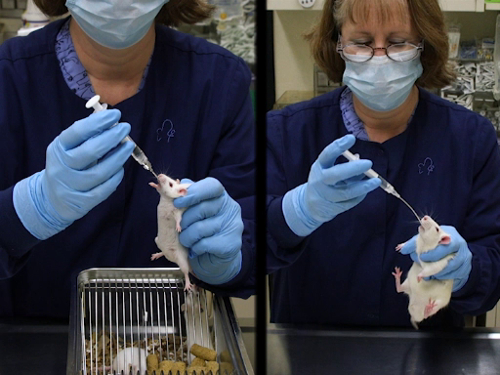药物注射 II
Overview
来源: 凯斯图尔特, RVT, RLATG, CMAR;瓦莱丽. 施罗德, RVT, RLATG。圣母大学
复合管理通常是动物研究的一个不可分割的组成部分。需要对许多因素进行评估, 以确保该化合物正确交付。行政路径影响着吸收机制。要引入的物质的特性 (pH 值、粘度和浓度) 可以决定选择哪种管理途径. 12, 3
Procedure
1. 专题应用
- 在涂抹任何软膏和药膏之前, 通过使用脱毛奶油或剃须, 将所有皮毛从该区域移走。
- 彻底清洁和干燥的皮肤。
- 将该物质直接涂抹在皮肤上, 用棉签或直接放置的下落, 以避免技术员的接触。
- 为了取得最佳效果, 应用几层薄薄的药膏或奶油, 而不是一层厚的一次性应用。
- 用分离的头发涂抹液体, 并在裸露的皮肤上涂抹一滴。
- 当在局部应用一种物质时, 由于动物对该区域的梳理, 有可能全身吸收。应采取预防措施, 避免意外摄入或及早清除该物质。小衣领或盾牌可以防止动物到达受影响的身体部位。个人住房也可能需要防止 allogrooming 的笼友。

图1。局部应用于小鼠。
2.
Application and Summary
References
- Turner, P.V., Pekow, C., Vasbinder, M. A., and Brabb, T. 2011. Administration of substances to laboratory animals: equipment and considerations, vehicle selection, and solution preparation. JAALAS. 50:5. 614-627.
- Shimizu, S. 2004. Routes of Administration in The Laboratory Mouse. Elsevier.
- Machholz, E., Mulder, G., Ruiz, C., Corning, B. F., Pritchett-Corning, K. R. 2012. Manual Restraint and Common Compound Administration Routes in Mice and Rats. J. Vis. Exp. (67), e2771, doi:10.3791/2771.
- Turner, P. V., Brabb, T., Pekow, C., Vasbinder, M. A. 2011. Administration of substances to laboratory animals: routes of administration and factors to consider. JAALAS. 50, 600-613.
- Hoggart, A.F., Hoggart, J., Honerlaw, M., and Pelus, L.M. 2010. A spoonful of sugar helps the medicine go down: a novel technique to improve oral gavage in mice. JAALAS. 49:3. 329-334.
- Gonzales, C., Zaleska, M.M., Riddell, D.R., Atchison, K.P., Robshaw, A., Zhou, H., and Rizzo, S.J. 2014. Alternative method of oral administration by peanut butter pellet formulation results in target engagement of BACE1 and attenuation of gavage-induced stress responses in mice. Pharmacology, Biochemistry, and Behavior. 126:28-35.
- Zumkehr, B., Hermann, C., Theurillat, R., Thormann, W., Gottstein, B., and Hemphill, A. 2012. Voluntary ingestion of antiparasitic drugs emulsified in honey represents an alternative to gavage in mice. JAALAS. 51:2. 219-223.
跳至...
此集合中的视频:

Now Playing
药物注射 II
Lab Animal Research
34.9K Views

啮齿动物的处理和克制技术
Lab Animal Research
174.3K Views

基本护理程序
Lab Animal Research
27.9K Views

育种和断奶的基本原理
Lab Animal Research
35.7K Views

啮齿动物识别 I
Lab Animal Research
54.7K Views

啮齿动物鉴定 (2)
Lab Animal Research
25.6K Views

药物注射 I
Lab Animal Research
100.4K Views

药物注射 III
Lab Animal Research
31.4K Views

药物注射 IV
Lab Animal Research
51.6K Views

血液采集 I
Lab Animal Research
171.5K Views

血液采集 II
Lab Animal Research
73.1K Views

麻醉诱导与维护
Lab Animal Research
50.4K Views

啮齿动物手术的考虑事项
Lab Animal Research
22.5K Views

诊断尸检和组织采集
Lab Animal Research
58.0K Views

无菌组织采集
Lab Animal Research
34.8K Views
版权所属 © 2025 MyJoVE 公司版权所有,本公司不涉及任何医疗业务和医疗服务。
